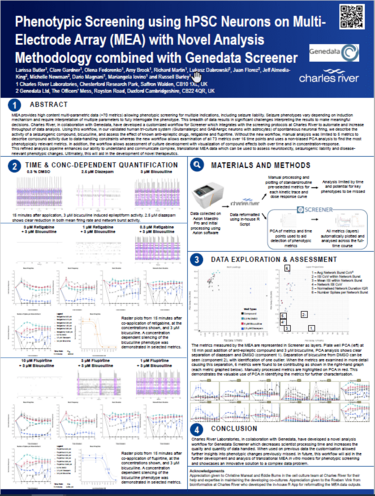Phenotypic Screening using hPSC Neurons on Multi-Electrode Array (MEA) with Novel Analysis Methodology combined with Genedata Screener
Genedata Biopharma Partner Symposium, Basel, Switzerland
March 7, 2024
MEA provides high content multi-parametric data (>70 metrics) allowing phenotypic screening for multiple indications, including seizure liability. Seizure phenotypes vary depending on induction mechanism and require interpretation of multiple parameters to fully interrogate the phenotype. This breadth of data results in significant challenges interpreting the results to make meaningful decisions. Charles River, in collaboration with Genedata, have developed a customized workflow for Screener which integrates with the screening protocols at Charles River to automate and increase throughput of data analysis. Using this workflow, in our validated human tri-culture system (Glutamatergic and GABAergic neurons with astrocytes) of spontaneous neuronal firing, we describe the activity of a seizurogenic compound, bicuculline, and assess the effect of known anti-epileptic drugs, retigabine and flupirtine. Without the new workflow, manual analysis was limited to 5 metrics to describe compound activity due to data-handling constraints whereas the new workflow allows examination of all 73 metrics over 16 time points and uses a non-biased PCA analysis to find the most phenotypically relevant metrics. In addition, the workflow allows assessment of culture development with visualization of compound effects both over time and in concentration-response.
This refined analysis pipeline enhances our ability to understand and communicate complex, translational MEA data which can be used to assess neurotoxicity, seizurogenic liability and diseaserelevant phenotypic changes. Ultimately, this will aid in the development of novel therapeutics.
